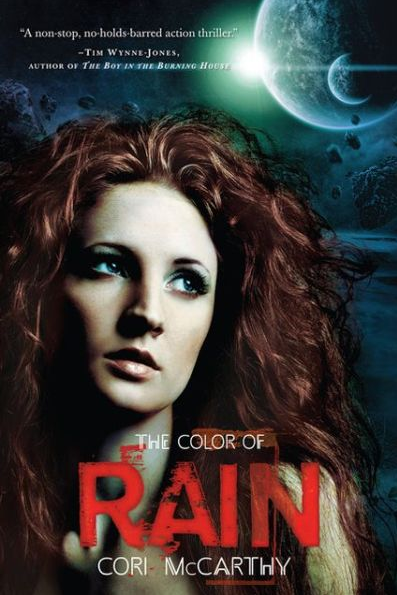The Next Big Thing in YA Dystopia
 I think we as a society don’t give our young adults enough credit—we’re continually underestimating what they can understand. That’s why I love young adult novels that don’t portray the world in black and white but in varying shades of gray—novels that explore complex and potentially divisive issues head on.
I think we as a society don’t give our young adults enough credit—we’re continually underestimating what they can understand. That’s why I love young adult novels that don’t portray the world in black and white but in varying shades of gray—novels that explore complex and potentially divisive issues head on.
The last few years have produced some exceptional young adult fiction, dystopian fiction in particular—The Hunger Games, Roth’s Divergent trilogy, Westerfeld’s Uglies saga, DeStefano’s Chemical Garden trilogy, etc.—and I’m officially adding Cori McCarthy’s recently released debut novel The Color of Rain to that elite list.
Unapologetically brutal, darkly poetic, and undeniably heart-wrenching, the novel is set on a future Earth that is irrevocably polluted by industry and whose impoverished inhabitants are increasingly becoming Touched, a disease which is like an evolved form of Alzheimer’s. Those who begin showing signs of the dread disease are tracked down by the police or bounty hunters and never seen again.
Rain White is a 17-year-old who has lost almost her entire family to the disease and its consequences—and her remaining family member, her younger brother Walker, is falling under the disease’s catatonic power. Her one chance to save her brother—and herself—is to somehow escape Earth and make it to an almost mythical place known as the Edge, a settlement on the other side of the known universe where an advanced form of humanity (known as Mecs) live.
When Rain meets a charismatic starship captain named Johnny Vale, who is essentially an interstellar pimp, she and her brother are offered passage off of Earth to the Edge… for a price. The cost is Rain’s body.
She makes an incredibly difficult decision—one that will hopefully save her brother—but she soon finds her situation onboard even more nightmarish than her miserable existence on Earth.
Vale isn’t just a sadistic pimp—he’s a slaver who kidnaps and transports the Touched and sells them as disposable labor to the highest bidders. Inside the ship are thousands of Touched slaves—people just like her deceased mother and the rest of her family—and Rain vows to somehow save them from their terrible fates.
But what can one supposedly “damaged” teenager really do?
I can hear the uproar already about a young adult novel that features a teenaged heroine who is a prostitute but, for me at least, it really wasn’t about that at all. The Color of Rain was about embracing courage and the life-changing—no, world-changing—power of hope.
But for all of its thematic intensity, it was McCarthy’s gripping writing style—which was simultaneously filled with vivid imagery and brutally blunt—that made this read so memorable. A suicide jumper’s head is likened to an “exploding sun,” for example, and Rain’s sexual encounters with Johnny are described brilliantly as “ugly syncopation.”
There are no sparkly vampires here, or friendly games of quidditch. Only a cast of flawed characters trying their best to survive in a fallen world.
Deeply thought-provoking and more than a little disturbing, The Color of Rain peers into the darkness of human nature and asks its readers some hard questions—questions with no easy answers.
Dystopian fiction fans who were attracted to the dark undertone of The Hunger Games and the thematic power of Roth’s Divergent saga should seek out McCarthy’s bleak vision of humankind’s future asap.